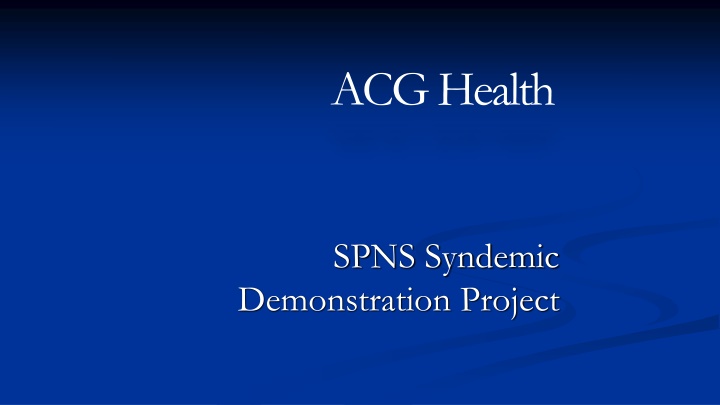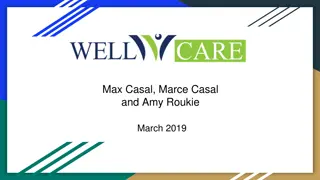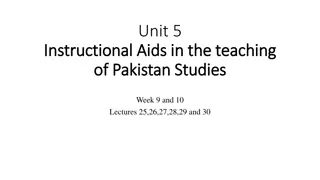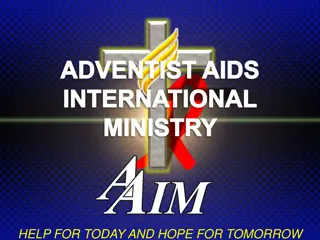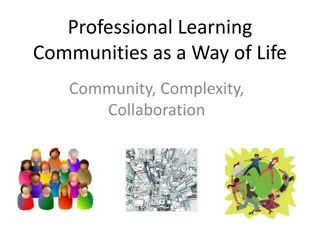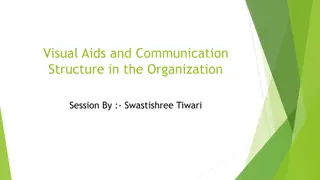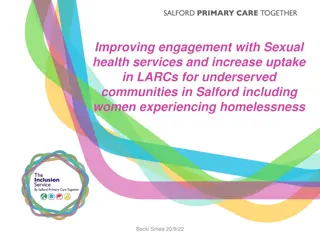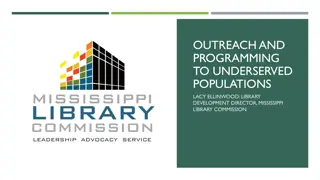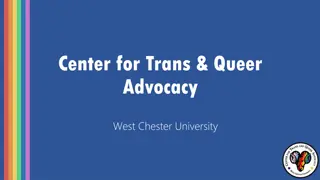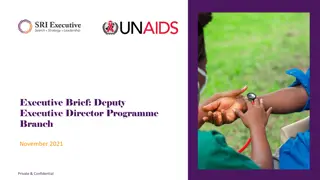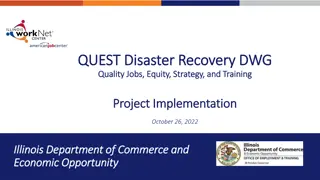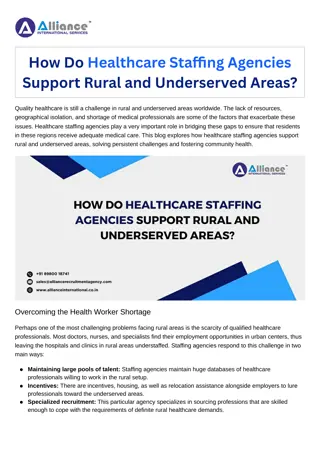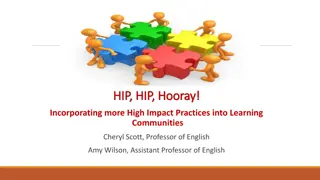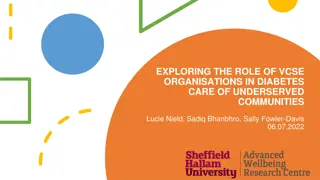AIDS Service Organization in Chester - Supporting Underserved Communities
Founded in 1998, an AIDS service organization in Chester, Pennsylvania, provides vital healthcare services to the underserved areas of Delaware County. Operating clinical sites and receiving various grants, the organization plays a crucial role in the local response to HIV/AIDS, with a specific focus on innovative care models funded by the Special Projects of National Significance (SPNS) grants.
Download Presentation

Please find below an Image/Link to download the presentation.
The content on the website is provided AS IS for your information and personal use only. It may not be sold, licensed, or shared on other websites without obtaining consent from the author.If you encounter any issues during the download, it is possible that the publisher has removed the file from their server.
You are allowed to download the files provided on this website for personal or commercial use, subject to the condition that they are used lawfully. All files are the property of their respective owners.
The content on the website is provided AS IS for your information and personal use only. It may not be sold, licensed, or shared on other websites without obtaining consent from the author.
E N D
Presentation Transcript
ACG Health SPNS Syndemic Demonstration Project
AIDS Service organization founded in 1998 Community based organization founded by clinicians to serve the underserved City of Chester and surrounding communities of Delaware County ORGANIZATIONAL OVERVIEW Geographical reach: The City of Chester and all of Delaware County - and the 4 additional suburban counties Southwest Philadelphia and central Philadelphia, The City of Reading in Berks county, and other parts of PA
Clinical sites Chester 2 clinical sites and one outreach center Sharon Hill dental, medical and psychology Reading medical Eddystone Pharmacy Services
Current Grants Current Grants Ryan White Part A Ryan White Part B Ryan White Part C Ryan White Part D SPNS Part F HIV Navigation Services IPV Capacity Grant Graduate Psychology Education Community Project Spending Congress Scattergood Foundation Harm Reduction PA Harm Reduction
The response to HIV/AIDS since the early 1990s has been a combination of federal, state, and local authorities designing and funding a multiple-track approach to care and treatment. For Pennsylvania, this includes: Part A Eligible Metropolitan Area (EMA) includes 4 of the 5 counties in southeastern Pennsylvania targeted for outreach; however, Philadelphia County, within the EMA is the only designated Ending the HIV Epidemic(EHE)county recipient; thus, excluding the EMA s suburban counties. Part B provides funding to seven consortia that cover the state s 67 counties. There are 22 Part C providers throughout the state. Part D funds 6 providers. CDC funds help to close gaps in STI testing; knowing that among the state s 67 counties there are only 6 with health departments doing STI testing, treatment, and surveillance. There is State funding to address individual care and prevention programs.
Special Projects of National Significance (SPNS) (Part F) Grants fund innovative models of care and supports the development of effective delivery systems for HIV care. AIDS Care Group received its first major 5 year grant in 2006 to establish a satellite dental program. This was followed in the following year with a SPNS grant to work with five county jails on prisoner release to durable HIV care.
The 9th SPNS grant: System-Level Syndemic Approach to Improve HIV Care and Treatment for People from Racial and Ethnic Minority Groups HRSA-24-107
Supported through funding from the Department of Health and Human Services Office of the Assistant Secretary for Health s Minority HIV/AIDS Fund, which funds projects to prevent HIV and improve health outcomes for racial/ethnic minority communities and in part by the Ryan White HIV/AIDS Program Part F Special Projects of National Significance
The purpose of this program is to support up to five demonstration systems through cooperative agreements for up to four years to design, implement, and participate in the evaluation of a syndemic approach to link and retain people with HIV from racial and ethnic minority groups who are out of care, and at greatest risk of being lost to care, in comprehensive
Linkage and Retention in Care This includes people who are newly diagnosed within the past 12 months or who have previously been diagnosed with HIV but have missed appointments, are not virally suppressed, or have another high-risk factor (e.g. leaving incarceration).
Grantees ACG Health Montefiore Medical Center Positive Impact Health Center Maryland Department of Health University of New Mexico Health Sciences Center Dallas County Health Department
Syndemic Approach A syndemic is a population-level clustering of two or more diseases or health conditions that interact to increase the health burden of the affected population: Syndemics are co-occurring epidemics or conditions that interact with one another, and often disproportionately impact morbidity and mortality in marginalized communities.
National Treatment Stats Over 1,000,000 US residents are living with HIV 550,000 are patients of a Ryan White Program 220,000 are believed to have unmet HIV healthcare needs. They are not in care. These are the persons who are targeted nationally in this project.
STATE DATA Pennsylvania, the United States sixth most populous state with a population of 12,970,814 reported 36,076 persons living with HIV/AIDS (3.4% of 1,210,212 United States living cases). Since 1981, more than 64,669 residents of Pennsylvania have been diagnosed with HIV disease and 28,600 of these persons have died.
More State Data: Incidence and Prevalence: The number of new cases DECLINED yearly from 1,462 in 2012 to 916 in 2022. But the number of those living with HIV disease has INCREASED over a 13-year period: 29,415 in 2009 to 36,076 in 2022 (an increase of 22.64%). Of the 36,076 persons living with HIV 34% (12,265) have unmet HIV healthcare needs. These are the State persons who are targeted in this project. When refining the geographic area and addressing minority patients, the targeted number is just under 1,000 persons.
This list of data points, measurable among residents within the five-county targeted population, accounts for over 1,000 minority persons living with HIV/AIDS who are not linked to care. Despite the counties public health network of clinical providers there are still patients who fall through the cracks and need outreach with interventions designed to help bridge the gaps between patients and providers.
REVIEW OF THE STRESSORS: Among the 5,574 residents of the five-county targeted population living with HIV/AIDS, 969 (17.38%) are minority patients who are not linked to care. State data is showing increases in STI infections, opioid use disorders, intimate partner violence, mental health needs, food insecurities, and homelessness. Fewer people are acquiring HIV, but more people are living with HIV. New patients are coming in with Late Diagnoses (indicating they convert to an AIDS diagnosis within 90 days). These patients have considerable immune deterioration and express extensive clinical needs for multiple healthcare problems.
The Syndemic Factors that will be Addressed: 1. HIV Care and Treatment 2. Substance Use and Mental Health Treatment Services 3. Social Determinants of Health: Intimate Partner Violence; Food Insecurities; and Access to Care
Rationale - 1. High levels of substance use disorders 2. High levels of STIs 3. Mental health conditions that have been left unaddressed 4. Long-standing histories of trauma and intimate partner violence 5. Subsistence at or below the federal poverty line with consequential housing and food insecurities throughout the targeted populations 6. Inability to access affordable primary care and services; and specialty medical care for co-morbid conditions.
Black, African American, and Latinx adults who are out of care or at risk of falling out of care, or newly diagnosed and engage in high-risk behaviors, such as those who engage with multiple sex partners in condomless sex; Sub-populations found in drug treatment centers, recovery houses, community corrections facilities, homeless shelters and jails. Counties to be reached: Chester, Delaware, Berks, Bucks, and Montgomery Counties. These five targeted counties combine to provide 9,710 of the State s 64,669 cumulative cases (15.01%); and 5,574 of the State s 36,076 currently living with HIV/AIDS cases (15.45%). Priority Populations
Priority Populations Patients in the targeted population are often found to have a lack of resources, but an abundance of co-existing medical and psychosocial diagnostic criteria including, but not limited to, hepatitis C, STIs, mental health diagnoses; substance use disorders, incarceration histories; histories of intimate partner violence; other domestic, housing, and food insecurities; and those experiencing discrimination, racism, and transphobia.
Our Team Mo Goodwin, MPH Michelle Scamuffa Bruce Schaffer Principal Investigator and Evaluator Outreach Director Data Manager
Intervention - Outreach This comprehensive approach to clinical and social services will be the basis of this demonstration project. Using the foundations of care established over 26 years and through the input of multiple SPNS grants, AIDS Care Group will work within the framework of HRSA sponsorship of an academic approach to the conceptualization of ways to advance evidence-informed outreach programs to ever-widening populations of minority patients who have unmet medical needs and an undisclosed number of co-morbid conditions. This is now being defined as syndemic needs among minority patients.
Outreach Indispensable component to our care 8 staff members peer navigation a key part of the role Monthly interdisciplinary outreach meetings to discuss patients lost to care, those with unsuppressed viral loads / those in need of close follow up HIV patients, testing for HCV, jail outreach, street outreach, recovery houses and treatment centers they go everywhere
FIVE SUBURBAN COUNTIES AIDS Care Group plans to expand upon years of outreach and linkages to care services to address a larger targeted population throughout five counties in southeastern Pennsylvania; increase the model and intensity of outreach activities; and document the value of the interventions. Utilizing three evidenced-based interventions to be seen as a singular and unique comprehensive program of outreach, staff of AIDS Care Group will test the following premise: By applying a bundled package of evidence-based interventions, social services, and access to comprehensive and compassionate care; AIDS Care Group can successfully help a cohort of 120 minority patients residing within a five-county region of Pennsylvania improve their health status by achieving and sustaining viral suppression, and therefore help to improve Pennsylvania s Continuum of Care.
Interventions and Syndemic Factors Deploy Community Health Workers (CHWs) to achieve success by working directly within targeted communities to initiate linkages and retention in care. Make appointments and travel arrangements for patients who are seeking re-engagement or are newly diagnosed. Provide rapid and sustained access into primary care and supportive services to alleviate disruptions in continuity of treatment and social supportive services and address syndemic factors: IPV; exposure to violence; or mental health or substance abuse concerns. Conduct needs assessments to identify barriers to care and develop a patient-centered care plan. Utilize Red-carpet Care to reduce barriers to care and provide support for access to comprehensive clinical care and social services. Provide patients with medication adherence and educational support. Link unstably housed patients to the housing counselor 1. 2. 3.
The demonstration project will: C. Work with the designated Education and Technical Assistance Provider (ETAP) 1. Data collection and dissemination Based on newly designed and approved models of care and data collection that have been approved by individual and multi-site combined Institutional Review Boards, AIDS Care Group s principal investigator will compile appropriate data provided through the ETAP and internal data sets to publish articles and manuals to help disseminate findings accumulated over the four-year grant period. 2. activities leading to successful clinical outcomes, but interview clients and collaborating agencies to document information about the motivating factors that best define the change from resistance to acceptance in medical treatment plans. Interviews - Participate not just in the outreach, linkage and retention in care 3. integrate the demonstration project s visions into sustainable programs that can be replicated - to improve case finding, linkages, and retention in care; and may influence funding for related services on a regional basis. Design and document the collaborations required within the region to help
Anticipated Outcomes Link and retain 120 individuals lost to care and newly diagnosed from the target population. Prove there is a seamless referral system that is identified, implemented, and sustained across the jurisdiction. Improve access, engagement, and retention in care. Identify and remove barriers found through assessments of social determinants of health. Identify and address other co-morbid medical conditions. Reach and maintain viral suppression; the primary clinical measure of improving individual and community health.
Pennsylvanias epidemiologic data indicates 48.2% of those living with HIV/AIDS have viral suppression (Revised Integrated HIV Prevention and Care Plan for Pennsylvania 2022-2026). However, there are unmet needs, a lack of access to medical treatment and social services, and disparities in health care outcomes among the state s minority patients located in southeastern Pennsylvania who are disproportionately affected by HIV/AIDS. Patients receiving HIV medical care within the nation s Ryan White programs have a viral suppression rate of 90%. Expanding Ryan White models of care and supportive services to more underserved populations in southeastern Pennsylvania may change the dynamics of clinical care for minority patients, remove disparities in health outcomes, and improve individual and community health markers.
A System-Level Syndemic Approach to Improve HIV Care and Treatment for People from Racial and Ethnic Minority Groups-Demonstration Systems is offering an opportunity through SPNS funding to suggest system-wide solutions to the syndemic nature of HIV morbidities. By utilizing models of care already found to be embedded in Ryan White programs, which are modified and adequately tailored to meet the unique needs of identified minority populations, AIDS Care Group hopes to improve case finding, linkages, and retention in care; with subsequent improvements in clinical outcomes.
